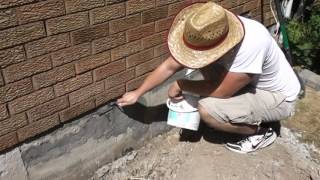Concrete Repair Perth
November 5, 2015
Concrete Foundation Repair Parging DIY, How to repair a concrete foundation by parging.,
Concrete Cutting, Sanding and Resurfacing
It’s one of the most commonly used construction materials in the world, and it’s as versatile as it is reliable, but what can be done if concrete starts to show the signs of its age? Fortunately, concrete is often used to last for decades at a time without any need for reparations, but it can sometimes be unavoidable to undertake a little concrete sanding and resurfacing project every so often – just to keep it as functional and supportive as possible.
Fixing Cracks
If there’s one weakness that concrete has, it’s the tendency for it to crack under pressure, or when exposed to the elements. In most cases, a crack in concrete can be treated with minimal fuss, but there are times where a crack runs deeper – or even worse; straight through the foundation. When this occurs, it’s important to rectify the damaged area, and if it’s very severe – a professional construction company should be called to address the matter.
Sanding Concrete
It’s not always cracks to look out for; in some instances, concrete can crumble and wear away over time, or when impacted with a blunt instrument. When this happens, the best thing to do is to fill the crumbled or damaged area, and then allow it several days to dry fully. Once the drying process has completed, you may be left with a slightly uneven surface. The best way to deal with this surface is to sand it down. This can be done manually via sand paper and a bit of elbow grease, or via an electronic appliance that sands and smoothens the area in no time at all.
Resurfacing Concrete
When exposed to the elements, or when used in a consistent fashion, it’s not uncommon for concrete to suffer with aesthetic damage and wear and tear. In extreme cases, the concrete will need to be removed in order for a fresh layer to be placed. But there are times where a concrete resurfacing may suffice. When resurfacing, the trick is to remove the older, external layer of concrete, and reveal a fresher, smoother layer. This is best done by using an electronic tool called a Concrete Resurfacing tool, and it works by breaking down the external layer of concrete, and then smoothing the layer underneath.
When working with concrete, it’s important to remember that protective gear is a necessity. Goggles, gloves and boots are vitally important, as concrete will possess chemicals that can be harmful if allowed to settle on human skin, or if breathed in (which is far more common when sanding and grinding concrete).
Although concrete is one of the most durable building materials around, and one that is used within homes, public places and everywhere in between, it’s important to remember that it isn’t invincible, and maintaining any exposed concrete present can make the difference between a long-lasting building, and one that begins to crumble and deteriorate as the years progress.